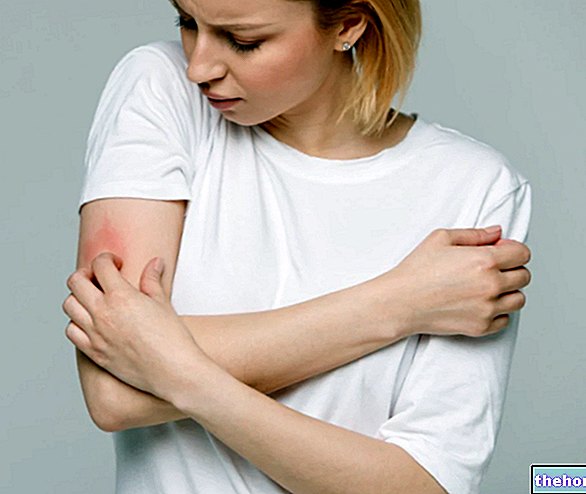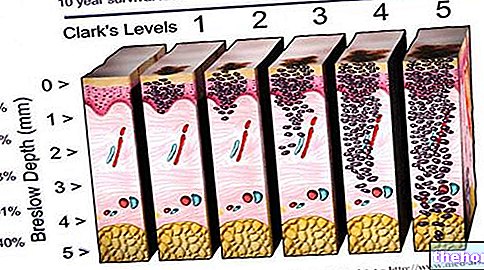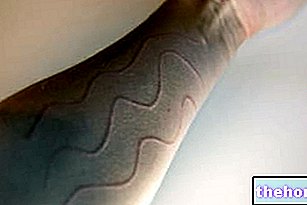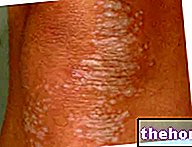Typical manifestations of this rash are: itching, redness, blistering and / or crusting.
Currently, the causes of eczema are still unclear. In this regard, the researchers hypothesized that a determining role is played by both environmental and genetic factors.
There are numerous types of eczema. The most common types of eczema are: atopic eczema, contact dermatitis, seborrheic eczema and asteatotic eczema. Some of the less common eczema are: dyshidrosis, discoid eczema, varicose eczema, herpetiform dermatitis and neurodermatitis.

There are several types of eczema; each of these types has some particularities, which an expert eye is able to recognize.
ARE ECZEMA AND DERMATITIS SYNONYMOUS?
In medicine, the terms eczema and dermatitis are synonymous, so they refer to the same inflammatory condition of the skin.
EPIDEMIOLOGY
According to some statistical surveys, the people around the world who suffered from eczema, in 2010, were about 230 million, or about 3.5% of the world population.
Eczema mainly affects young people: for example, in the United Kingdom, about 20% of children suffer from dermatitis; in the United States, about 10%.
The sex most affected is the female one.
Curiously and for still unclear reasons, from 1940 to 2000, the incidence rate of eczema has been increasing. In other words, over the years, eczema has become an increasingly common problem.
An interesting US study from 2010 investigated how common eczema was in that year among individuals with a job in the United States. It found that dermatitis affected about 10% of workers (ie more than 15 million individuals) and was particularly prevalent among health and social workers.
GENETIC FACTORS
By analyzing the genetic profile of numerous patients with eczema, the researchers noted that many test subjects expressed some specific genes differently from normal.
Furthermore, paying attention to the family history of the same patients and others, they found that eczema was a recurring problem within different families.
These two curious discoveries, therefore, have led experts to think that, in some cases, eczema has a genetic-hereditary basis.
Among the genes that seem to affect the presence of some types of eczema, the gene for filaggrin, a protein present in the epidermis and which binds keratin filaments, deserves a special mention.
Curiosity
For reasons still unknown, people with celiac disease develop eczema three times as often as people without celiac disease. Read the in-depth study
Typically, the most characteristic sign of eczema is the rash, also known as rash or rash.
An "eczema rash may present with or without blisters; may be the site of redness, irritation, swelling and / or dry skin; may coincide with a" highly itchy (ie itchy) area; may develop suppurative and / or crusted lesions; etc.
It is important to point out that the characteristics of the rash strongly depend on the type of eczema in progress.

SEAT OF THE SKIN ERUPTION
The location of the body affected by the rash depends on the type of eczema.
However, the most commonly affected regions are: the neck, trunk (chest, belly and back), hands, wrists, forearms, legs and ankles.
It is quite rare that the rash eczema appears at the level of the genitals, therefore in the vicinity of the vulva or scrotum. However, when this happens, the symptoms and signs are quite intense and with a tendency to "come and go".
COMPLICATIONS
Complications of eczema are often linked to very intense itching.
In fact, a particularly marked itchy sensation induces the individual with eczema to repeatedly rub the skin, thus causing skin lesions from scratching.
Such cutaneous lesions represent, for the bacteria, a possible way of access to the organism.
The entry of bacteria into the body can trigger an infection, the typical symptoms of which are: high fever, the appearance of pus and acute pain.
Doctors resort to more in-depth analyzes - such as allergy tests and skin biopsy - when doubts remain about the type of eczema.
and various drugs, including:
- Corticosteroids for topical or oral use (N.B: "topical use" means that the preparation in question must be applied directly to the affected area).
- Topical immunosuppressants.
- Topical or oral antibiotics.
- Antihistamines.
For some types of eczema, doctors may also prescribe some form of phototherapy (photochemotherapy, photodynamic therapy, etc.).
EMOLLIENTS
All preparations capable of softening, moistening and making the superficial layers of the skin more elastic are emollients.
Clearly for topical use, emollients relieve rash disorders and help the skin restore its normal appearance.
CORTICOSTEROIDS
Corticosteroids are powerful anti-inflammatory drugs belonging to the steroid family.
If taken for long periods of time and / or in excessive doses, they can have serious side effects, such as: osteoporosis, diabetes, cataracts, hypertension or obesity.
Two corticosteroids particularly used in the presence of eczema are hydrocortisone and clobetasol propionate.
Side effects of topical corticosteroids consist of: acne, increased hair growth, telangiectasia and skin thinning.
IMMUNE SUPPRESSORS
Immunosuppressants are medicines that reduce the effectiveness of an organism's immune defenses.
Thanks to this property, they are able to alleviate the inflammatory response, which eczema sets in motion.
As for the side effects, it should be remembered that the intake of immunosuppressants makes the body more fragile, increasing the susceptibility to infections.
Topical use
Systemic use
- Pimecrolimus
- Tacrolimus
- Cyclosporine
- Azathioprine
- Methotrexate
ANTIBIOTICS
Doctors prescribe the use of antibiotics only if some skin area affected by eczema has developed a bacterial infection.
ANTIHISTAMINS
Antihistamines are medicines that block the release of histamine, a compound produced by some cells of the body and released in case of inflammation.
Doctors prescribe antihistamine-based treatment when eczema causes intense itching and irritation.
A widely used antihistamine in the presence of dermatitis is diphenhydramine.
For further information: Medicines to Treat Eczema and eczema due to particular morbid conditions (infections, lymphomas, etc.).
ATOPIC ECZEMA
Atopic eczema, or atopic dermatitis, is the most common type of eczema in humans.
According to doctors and experts in skin diseases, it would be an allergic disorder, with a genetic-hereditary component.
Particularly common among children (but potentially capable of onset at any age), atopic dermatitis mainly affects:
- Individuals suffering from asthma or hay fever.
- Individuals with a family history of eczema, asthma, or hay fever (thus individuals with relatives suffering from one of these conditions).
- Individuals with some defect in the skin barrier.
Atopic eczema rash typically involves itching, erythema, skin redness, and blisters.
Encouraged by contact with soaps, rough clothing, some household chemicals and / or dust mites, the manifestations of atopic eczema mostly affect the face, hands, feet, the inner part of the elbows and the back of the knees.
The most suitable treatments include: the use of emollients, the application of corticosteroids on the affected areas, the administration of immunosuppressants and antibiotics (if there are bacterial infections) and finally some photochemotherapy sessions.
For further information: Atopic eczema symptoms
CONTACT ECZEMA
Contact eczema, or contact dermatitis, is an inflammatory skin condition that appears after contact with substances that are harmless to most people.
Contact dermatitis can be of two types: irritative contact dermatitis and allergic contact dermatitis.
- Irritative contact dermatitis results from the interaction (sometimes occasional, sometimes repetitive) with particularly powerful irritants, such as sodium lauryl sulfate.
- Allergic contact dermatitis, on the other hand, arises as a result of interaction with allergens (ie substances that trigger an allergic reaction in some individuals).
Some typical allergens that characterize contact dermatitis are: nickel, poison ivy and cosmetics containing the so-called balsam of Peru.
Mainly located in the hands, contact eczema causes a rash characterized by itching, swelling, dry skin and redness of the skin.
The most suitable treatments include: the application of emollients, the use of corticosteroids, the use of antihistamines and, only in the presence of bacterial infections, the intake of antibiotics.
In the presence of allergic contact dermatitis, doctors recommend avoiding contact with any product or substance that contains the allergen.
SEBORRHEIC ECZEMA
Seborrheic eczema is a typical condition of the scalp, which in some cases can also affect the eyebrows, the sides of the nose, the anatomical area behind the ears, the groin and the center of the chest.
Seborrheic eczema causes a rash characterized by the formation and loss of greasy scales. At the scalp level, these greasy scales take the generic name of dandruff.
The precise causes of seborrheic eczema still remain unknown. However, the researchers believe that the infections produced by the fungus Malassezia furfur are a possible contributing factor to this type of dermatitis.
The most suitable treatments include: the use of detergents and shampoos based on salicylic acid, selenium, zinc or coal tar; the application of corticosteroids; and finally the intake of antifungal preparations.
To know more:
Seborrheic dermatitis symptoms Seborrheic dermatitis drugs
ASTEATOSIC ECZEMA
Asteatotic eczema, or xerotic eczema or xerosis, is a skin inflammation that causes, above all, hardening and dryness of the skin and, less frequently, itching.
It is typical of old age and is usually located in the limbs and trunk.
DEHYDROSIS
Dyshidrosis, or dyshidrotic eczema or pompholix, is a dermatitis that mainly affects the hands and feet.
Generally, it is responsible for a "skin rash, characterized, in the initial phase, by blisters and itching and, later, by redness.
Dyshidrosis has, in many cases, the characteristics of a chronic disorder.
The most effective treatments and remedies include: the administration of corticosteroid drugs, phototherapy (in particular photochemotherapy) and the application of wet / cold compresses on symptomatic areas.
ECZEMA DISCOIDE
Discoid eczema, or nummular eczema, is a dermatitis that causes brownish-red, oval or circular patches on various parts of the body.
The anatomical sites most affected are: the forearms, hands, feet, trunk and legs.
The precise triggers of discoid eczema are unknown, although some clinical studies report the possible influence of the condition of dry skin.
The most effective treatments include: the application of emollients, the administration of corticosteroids and the intake of antibiotics (if there is an infection).
ECZEMA FROM STASI VARICOSO
Stasis eczema, or venous dermatitis or varicose dermatitis, is an inflammation of the skin that people with venous circulation problems in the legs develop (varicose veins, reduced venous return to the heart, etc.).
With totally unknown causes, stasis eczema causes a rash characterized by redness, itching, scaling, and dark skin.
It is more common in people over the age of 50.
ECZEMA HERPETIFORME
Eczema herpetiformis is a dermatitis that produces a rash, characterized by blisters and itching and with a symmetrical appearance.
The anatomical areas most affected are: the arms, legs, knees and back.
For reasons still unknown, eczema herpetiformis is particularly common among people with celiac disease.
NEURODERMATITIS
Neurodermatitis is a particular eczema that appears in those who have the nervous habit of scratching in a certain area of the skin.
Typically, it causes itching and thickened skin.
To heal, the remedies consist of finding a way not to scratch and taking some anti-inflammatory drugs.
SELF-ECZEMATIZATION
Self-eczematization is a type of eczema that appears as a result of parasitic or fungal, bacterial or viral infections.
Typically, the site of the rash is distant from the site of infection.
By adequately treating the infection that favors it, self-eczematization is treatable with excellent results.
PERIORAL DERMATITIS
Perioral dermatitis is eczema that causes a rash around the mouth.
Typical features of this rash are: the presence of blisters, itching and burning.
Possible risk factors include: the use of fluoride-based toothpastes, the use of oral contraceptives, the application of some cosmetics, the use of some detergents, exposure to cold, etc.
Typically, doctors treat this type of eczema with immunosuppressants and antibiotics, and advise against sun exposure.









.jpg)


















